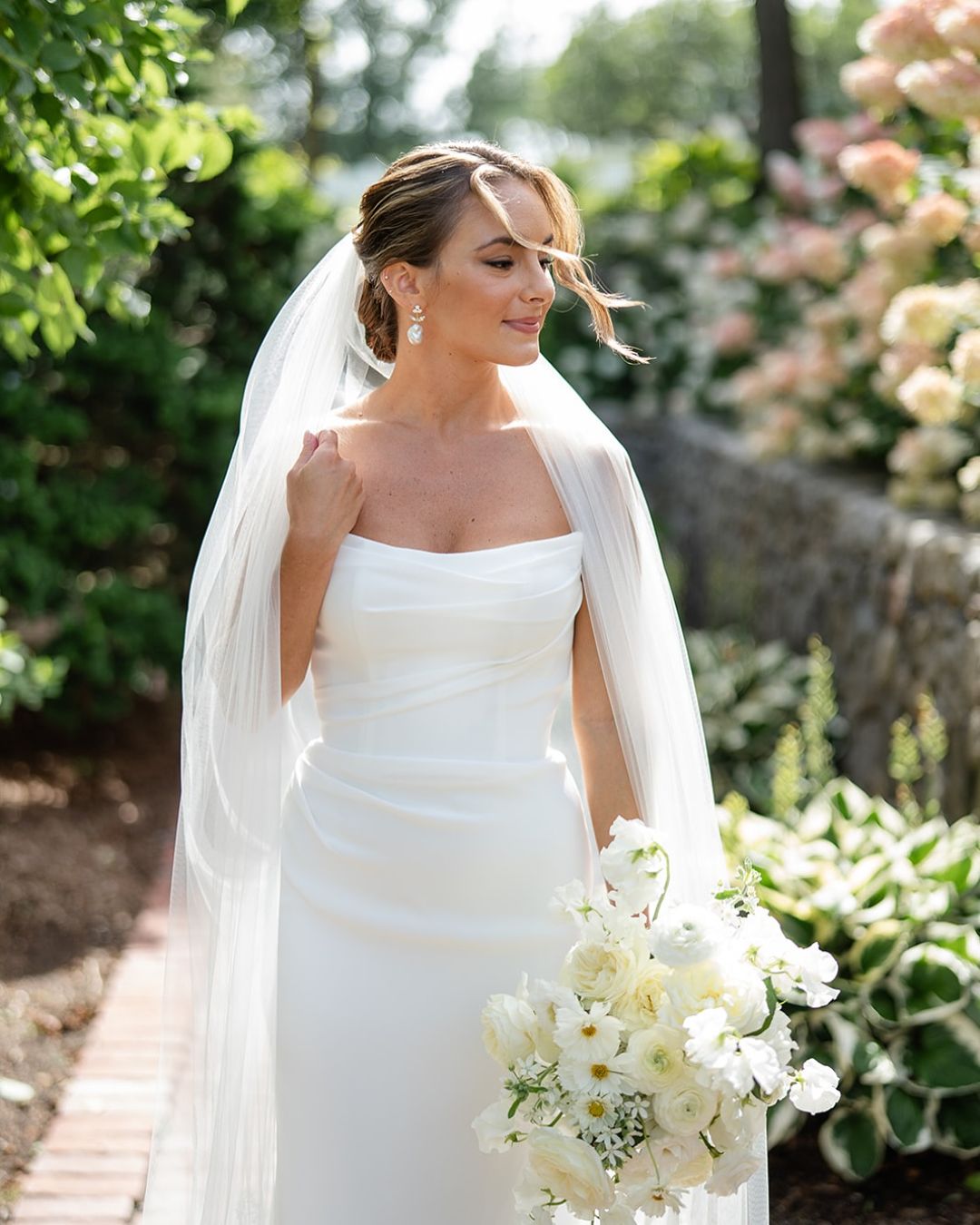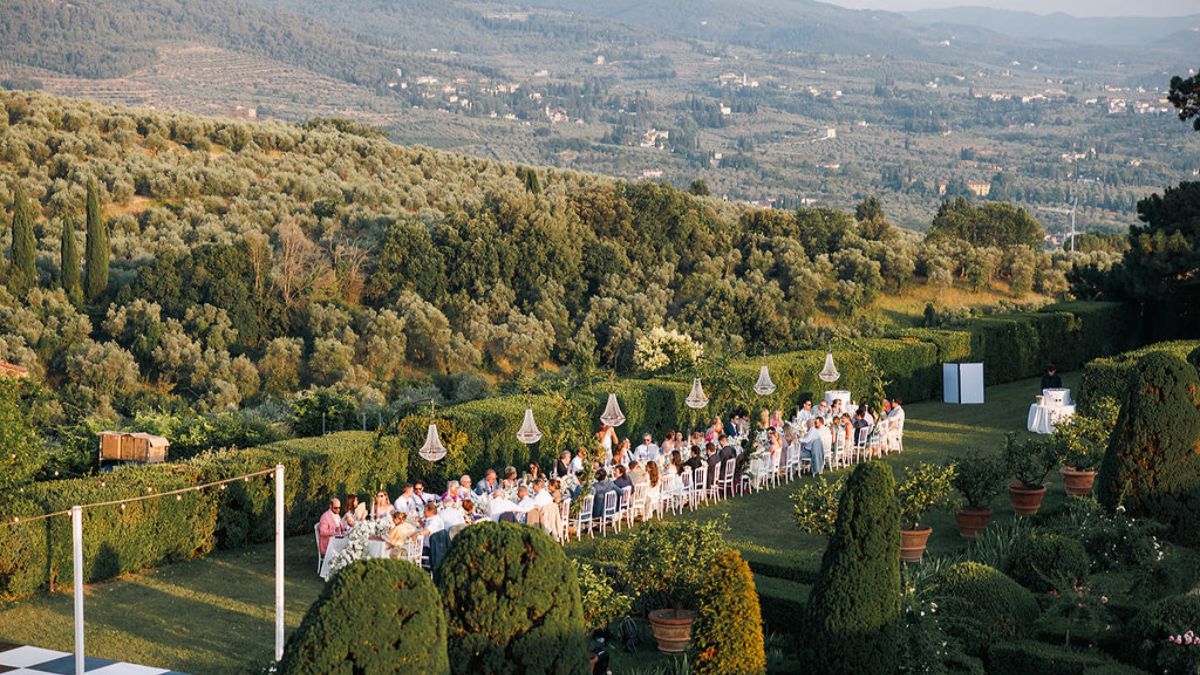You get engaged and start planning your wedding. The two of you fall in love with a venue and they give you the entire breakdown. You get home and start going over your guest list, but quickly run into problems. Whether you simply have too many people on the list for the venue limit, or it’s a budget conflict, we have some pro tips from top wedding industries to help you sort it out. They share how to create separate lists, what to take into consideration and if it’s even considered okay!

Image via By Julietta
Maya Holihan, founder & CEO, of EWedded shares,
Make a preliminary list first.
“You certainly don’t have to have the same guest list for your ceremony and your reception. However, there are a few key things to keep in mind, if that’s the choice you make! First, we recommend making a preliminary list, with your fiancé, for both the ceremony and the reception. This is the best way to figure out who each of your must-include people are. Then, start to narrow it down into two separate lists – one for the ceremony and one for the reception.
Another key thing to remember is to be clear with your guests. No, you don’t have to explicitly say “you’re not invited to this portion of our wedding”. We DO recommend, however, creating separate invitations so that it’s very clear what exactly each guest is invited to. This should include if an invitation to the ceremony only, the reception only, or both. It’s better to avoid the risk of confusion to ensure your day is exactly what you’re envisioning!”

Image via Sweetlife Photography
Andaleeb, from Atelier Azure, shares a few pro tips,
Figure out where the overlap is.
“Determine how many guests lists you have and what the overlap is between them. Is it a difference between the ceremony guest list and the reception guest list, or do you also have a rehearsal dinner, a farewell brunch or other ceremonies to consider? There will likely be some overlap in guests between these lists. Ultimately, you need the number of guests receiving the complete invite & the number of guests receiving only the reception card (or the “edited” invite)”

Image via Brogen Jessup Photography
When in doubt, hire professionals to help.
“Our most important tip for more complex weddings with multiple events is to hire professionals to help with the specifics. It’s so easy to overlook the details of how your events are separated for your guests – especially if you are planning the wedding all at once. It really helps to have people on your team who have created this type of invitation in the past – and we are always happy to help!”
Be clear with your wedding website.
“If it’s not possible to have two wedding websites, you may need to wordsmith your website text to explain. This is to make sure more intimate events are not viewable by the larger guest list. Kind but also clear verbiage like, “We look forward to celebrating our wedding with you! We have opted for an intimate ceremony at our home with a larger reception at The Ritz Carlton Hotel. We can’t wait to see you there!” This verbiage is helpful for those guests wondering why their invitation card only mentions the reception.”


Images via RT Faith Photography
Different cultures provide opportunities for different guest lists.
“As invitation designers, we often see different guest lists for different wedding events in our work, especially when there are different cultures. Our clients choose this strategy for their weddings for many reasons. Sometimes couples want a more intimate ceremony with just family present, budgetary concerns, health concerns, logistical and geographical concerns, or even language and cultural differences for different events. The key to pulling this type of wedding structure off well, is clear and gracious communication. Here are some tips on creating invitations for this situation without offending anyone.
Plan your invitation and communication to avoid giving any information about an event they are not invited to. Instead of a single card, your invitation suite will likely require multiple cards one for each event. You will also need separate RSVP cards for each event or guest list. And you may even need separate details cards if you are including any event specific information. All of these pieces can be brought together in one “folio” or “pocket for a clean and elegant look for the guests invited to everything.”

Image via Carmen Lopez Photography
Ashley Lachney, owner of, Alston Mayger Events, shares,
Put yourself in your guests’ shoes before you make any decisions.
“While there are specific situations where a smaller ceremony and larger reception works, I always encourage my couples to put themselves in their guests’ shoes. Would you want to be asked to participate in an event (and, let’s face it, spend money on travel, getting ready, and a gift), only to be told that you won’t be invited to witness the exchanging of vows? Your friends and family want to be there to bear witness to your love, so most of the time, it’s a no-brainer to include the same folks at both ceremony and reception.”

Image via Ximean Zermeño Photography
Jenna Miller, Creative Director of, Here Comes The Guide,
Keep invites crystal clear.
“Technically, no, your guest list doesn’t have to be the same for your ceremony and reception! If you want a super intimate ceremony followed by a big fabulous party, you can absolutely make it happen. The only etiquette caveat is that whoever is invited to the ceremony must also be invited to the reception. But it’s totally acceptable to invite guests only to the wedding reception. Just make sure your reception-only invitations make it crystal clear that it’s for the reception—only! For example, instead of inviting guests to “witness” your marriage, invite them to a “reception to celebrate” your marriage. You can then invite the VIP ceremony guests via an additional paper insert, an email, or a phone call.”

Image via LAR Weddings
Nora Sheils, Founder of Bridal Bliss, and Co-Founder of Rock Paper Coin, shares,
Don’t prioritize cost savings over feelings.
“While etiquette has changed quite a bit when it comes to the wedding world, one thing remains true – treat your guests with respect and give them a positive experience at your event reigns king! Planning a small ceremony and a larger reception is more than acceptable. Many couples cringe at the thought of people watching them walk down the aisle. Keeping the ceremony small makes it much less stressful. However, asking guests to attend your ceremony and then not inviting them to the reception isn’t going to fly. It may be a cost savings, but I can guarantee you that you will have many offended guests.”

Image via Anoki Art Photography
Lauren Lemke, Executive Event Designer at Amy Abbott Events shares,
For destination weddings, the rule of thumb is that all guests should be invited to both.
“If you are planning a destination wedding, all guests should be invited to both the ceremony and reception. The only exception to this rule is when it comes to children. I have noticed a trend where children are invited to the ceremony and cocktail hour, then head back to the hotel with the babysitter or grandparent before dinner. This is a nice compromise for those couples who are looking to have an adults’ only party. It also allows the parents of the children to spend a care free night on the dance floor with the bride and groom.”

Image via LAR Weddings
HoneyFitz Events shares,
It’s nice to be all-inclusive if your ceremony and reception are at the same venue.
“Guest lists for your wedding day can be challenging to navigate. Some couples opt for more unique and personal celebrations and there are ways to address the question of the guest list. Some couples choose to have an intimate civil or church ceremony with limited guests in attendance. Then, later on, have a full-blown reception, where they expand on the guest list. Inversely, if a couple is looking to limit the number of guests in attendance for the reception, an option to consider is having the ceremony and reception in different locations or on different days. This allows for the opportunity to adjust the guest list. As a general rule of thumb, if your ceremony and reception are being held at the same venue, it’s nice to be inclusive with all guests.”

Image via Sarah Sayeed
Charlotte Ricard-Quesada, La Fete shares,
Consider splitting the reception list.
“Having a separate ceremony and reception guest list is a very common thing in the UK. However, it still seems to be a huge question elsewhere in the world. The UK takes it one step further where the reception is split into two further guest lists: dinner and dancing. The rule goes that your family and very close friends are at the ceremony. It should be intimate and simple. You then have more friends and secondary family meet you for cocktails and the meal. This should be fun and everyone should be able to connect with the speeches given. Then, you can invite work colleagues, or people that are obligation invitations to the dancing. They can mingle, enjoy the party and essentially cost a lot less, than if you had invited them earlier. The best part? Everyone is still expected to give some sort of gift to the couple.”
We hope you found these pro tips from top wedding industries helpful for your wedding planning journey! We think you’ll also love these ’10 tips for the morning of your wedding‘.





